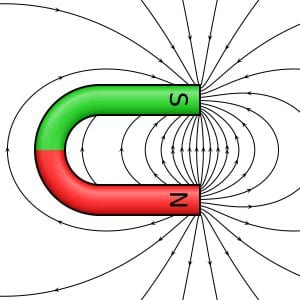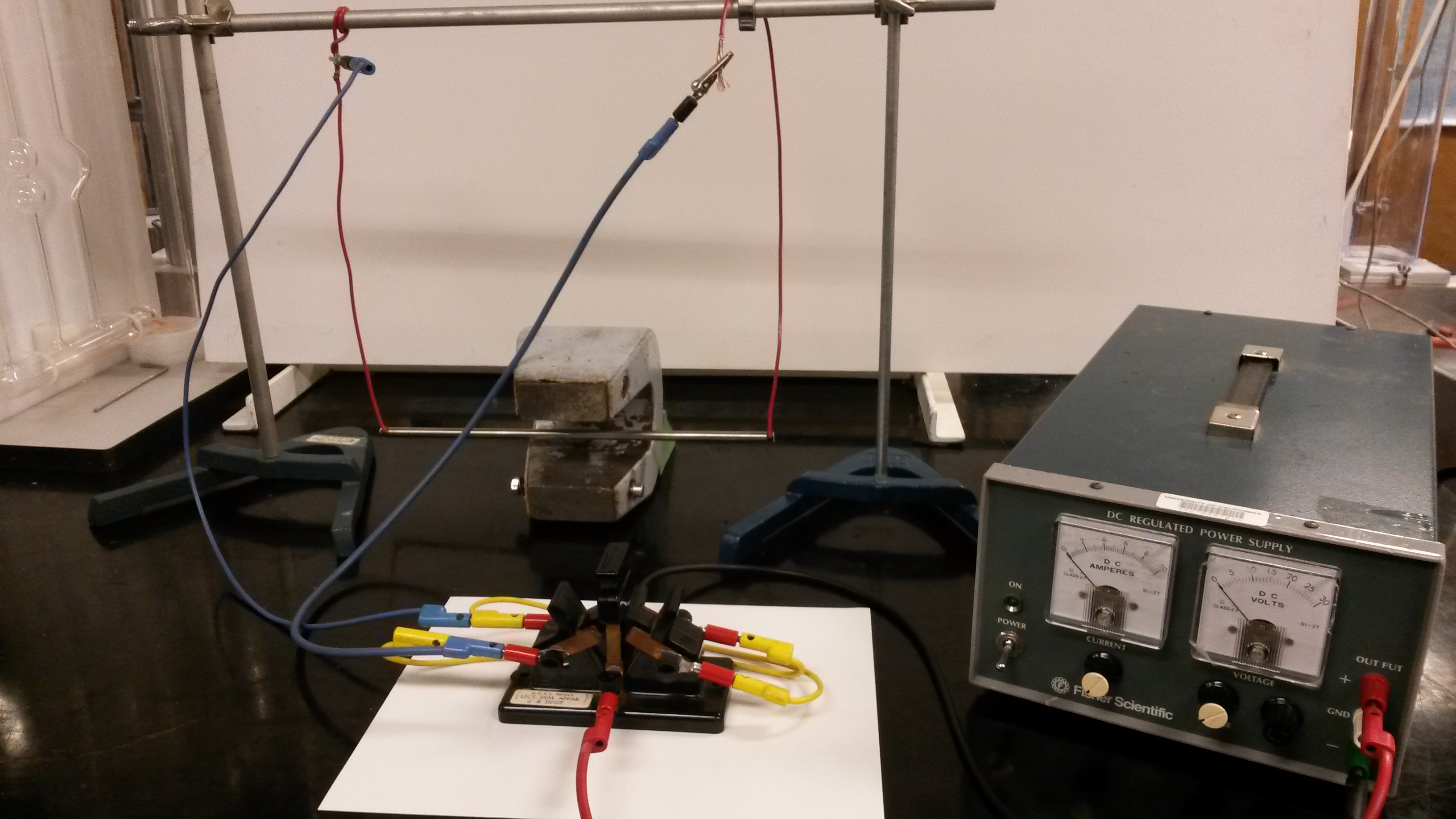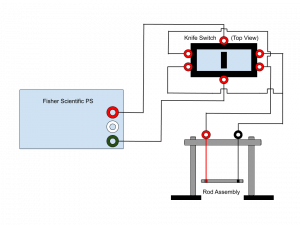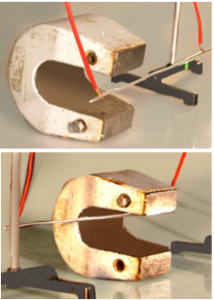An aluminum rod is suspended between the poles of a large magnet. If there is no current through the rod, it swings freely. When the rod carries a current, there is a force which pushes or pulls the rod, depending on the direction of the current. This is shown in Figure 1 above.
Equipment:
- Double knife switch
- Aluminum rod
- Wires with copper thread exposed (for winding around the rod)
- Giant horseshoe magnet
- Two rod/stand setups with another support rod/clamps
- Fisher scientific DC power supply
- Banana cords (4)
- Rubber clamps
- Video camera
Demo:
- Position the aluminum rod such that it is suspended in the middle of the magnet (not touching any side of it). The magnet has its north and south pole labeled, in order to help determine the direction of the magnetic field.
- With the knife switch straight up (voltage mode), hook up the banana cables according to the diagram in Figure 2 above.
- Connect the two single banana jacks on either side of the knife switch to the power supply.
- Double check that the current knob is set to zero on the PS, then turn on the PS.
- Increase the voltage to about 10 V.
- Flip the knife switch either to the right or left (current mode) and turn the current up. The rod will swing either in or out of the magnet, depending on the direction.
- To change the direction of the rod’s swing, turn the current to zero, flip the knife switch to the opposite side, and turn the current back up again.
Explanation:
The premise of this demonstration is to show how a current carrying wire positioned in a magnetic field will experience a force known as the Lorentz force (where the electric filed is 0). This is shown in the equation below:
F is the magnetic force on the wire, I is the current, L is the length of the current-carrying wire, and B is the external magnetic field.
The magnetic field created by the horseshoe-shaped magnetic is a constant magnetic field, whose magnetic field lines are shown below in Figure 3.

Figure 3: Magnetic field of a horseshoe-shaped magnetic (Horseshoe magnet. (2018, December 30. https://en.wikipedia.org/wiki/Horseshoe_magnet)
The wire is placed between the ends of the magnet, where we approximate a uniform magnetic field. Due to the set up of the magnet in the demonstration, this magnetic field can either be up or down. The wire is set up in a way where the current will flow either to the left or to the right if you are facing the demonstration. The set up of this demonstration can be seen in Figure 1.
Once current begins to flow, the current-carrying wire will experience a force since it is submerged in a magnetic field. The direction of this force is determined by the Lorentz force, which relates how a moving charge in an external magnetic field will experience a force. This equation is given above. Figure 4 below shows the resulting effect.
Assume that the magnetic field is pointing up in Figure 4 to stay consistent with Figure 3. In the top picture of Figure 4, we can determine that the Lorentz force on the wire is pointing away from the magnet, and we use our assumption that the magnetic field is pointing up. By using the cross product in the Lorentz equation, we can figure out that the current in the wire is moving from left to right, in respect to Figure 4.
The bottom picture of Figure 4, we see that the Lorentz force on the wire is pointing in to the magnet. Again, we assume that the magnetic field points up. By using the cross product in the Lorentz equation, we can figure out that the current in the wire is moving from right to left, in respect to Figure 4.
Now, if we assume that the magnetic field points down, we could use the same reasoning above to find that the direction of the current in the wire will switch. To see this, let us start with the top picture in Figure 4. We assume that the magnetic field is pointing down, and the wire seems to experience a force that pushes it away from the magnet. By RHR, we determine the the current is flowing from right to left in respect to Figure 4. In the bottom picture in Figure 4, we maintain the assumption that the magnetic field is pointing down, but now the wire to experiences a force that pulls the wire inside of the magnet. RHR thus tells us that the current is flowing from left to right through the wire, in respect to Figure 4.
Notes:
- It is best to turn the current off before flipping the knife switch to avoid a sudden large change in current
- Watch out for bad knife switch connections!
- The magnet is VERY STRONG so be careful around metal objects.
Written by Ryan Dudschus


